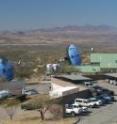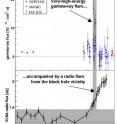Pinpointing origin of gamma rays from a supermassive black hole
Related images
(click to enlarge)
An international collaboration of 390 scientists reports the discovery of an outburst of very-high-energy (VHE) gamma radiation from the giant radio galaxy Messier 87 (M 87), accompanied by a strong rise of the radio flux measured from the direct vicinity of its super-massive black hole. The combined results give first experimental evidence that particles are accelerated to extremely high energies of tera electron Volt (one electron Volt is the energy an electron or proton gains when it is accelerated by a voltage of one Volt) in the immediate vicinity of a supermassive black hole and then emit the observed gamma rays. The gamma rays have energies a trillion times higher than the energy of visible light.
The large collaborative effort involved three arrays of 12-meter to 17-meter telescopes that detect very high-energy gamma rays and the Very Long Baseline Array (VLBA) that detects radio waves with high spatial precision.
Washington University in St. Louis scientists Matthias Beilicke, Ph.D., postdoctoral research associate in physics in Arts & Sciences, and Henric Krawczynski, Ph.D., associate professor of physics, working with VERITAS (Very Energetic Radiation Imaging Telescope Array System), coordinated this cooperative project for the VERITAS collaboration, the results of which will appear in the July 2 Science Express, the advance online publication of the journal Science.
"We had scheduled gamma-ray observations of M 87 in a close cooperative effort with the three major gamma-ray observatories VERITAS, H.E.S.S. and MAGIC, and we were lucky that an extraordinary gamma-ray flare happened just when the source was observed with the VLBA and its impressive spatial resolving power," says Beilicke.
"Only combining the high-resolution radio observations with the VHE gamma-ray observations allowed us to locate the site of the gamma-ray production," says R. Craig Walker, Ph.D., staff scientist at the National Radio Astronomy Observatory in Socorro, New Mexico.
M 87 is located at a distance of 50 million light years from Earth in the Virgo cluster of galaxies. The black hole in the center of M 87 is six billion times more massive than the Sun. The size of a non-rotating black hole is given by the Schwarzschild radius. Everything — matter or radiation — that comes within one Schwarzschild radius of the center of the black hole will be swallowed by it. The Schwarzschild radius of the supermassive black hole in M 87 is comparable to the radius of our Solar System.
In the case of some supermassive black holes — as in M 87 — matter orbiting and approaching the black hole powers highly relativistic outflows, called jets. The matter in the jets travels away from the black hole, escaping its deadly gravitational force. The jets are some of the largest objects in the Universe, and they can reach out many thousands of light years from the vicinity of the black hole into the intergalactic medium.
VHE gamma-ray emission from M 87 was first discovered in 1998 with the HEGRA Cherenkov telescopes. "But even today, M 87 is one of only about 25 sources outside our galaxy known to emit VHE gamma rays," says Beilicke.
The new observations now show that the particle acceleration, and the subsequent emission of gamma rays, can happen in the very "inner jet," less than about 100 Schwarzschild radii away from the black hole, which is an extremely narrow space as compared with the total extent of the jet or the galaxy.
In addition to VERITAS and the VLBA, the High Energy Stereoscopic System (H.E.S.S.) and the Major Atmospheric Gamma-Ray Imaging Cherenkov (MAGIC) gamma-ray observatories were involved in these observations.
Measurement of VHE gamma rays with Cherenkov telescopes
The VHE gamma rays with energies ranging from hundred GeV (one billion electron Volt) to several 10's of TeV (one trillion electron Volt) are measured with Cherenkov telescopes with mirror diameters of up to 17 m (56 feet). The gamma rays coming from distant cosmic particle accelerators are absorbed in the Earth's atmosphere, where they give a short-lived shower of particles.
The Cherenkov telescopes detect the faint, extremely short flashes of blue light, which these particles emit (named Cherenkov light) using extremely sensitive cameras. The images can be used to infer the arrival direction and initial energy of the primary gamma rays.
The three telescope systems involved in the observations are located in Arizona, USA (VERITAS); Namibia, Africa (H.E.S.S.); and on the Canary Island La Palma, Spain (MAGIC).
Coordinating the observations between the three experiments resulted in an observation of time of about 120 hours in 2008, allowing for the detection of the strong gamma-ray flares.
High-resolution radio imaging with VLBA
The VLBA is a system of 10 radio-telescope antennas, each with a dish 25 meters (82 feet) in diameter and weighing 240 tons. From Mauna Kea on the Big Island of Hawaii to St. Croix in the U.S. Virgin Islands, the VLBA spans more than 5,000 miles, providing astronomers with the sharpest vision of any telescope on Earth or in space.
Dedicated in 1993, the VLBA has an ability to see fine detail equivalent to being able to stand in New York and read a newspaper in Los Angeles. From January 2007 to April 2008, Craig Walker and co-workers used the VLBA to make a "43 GHz movie" of the plasma outflow from the supermassive black hole in the radio galaxy M 87.
Source: Washington University in St. Louis
Articles on the same topic
- A galaxy as particle acceleratorMon, 6 Jul 2009, 15:14:33 UTC
- VLBA locates superenergetic bursts near giant black holeThu, 2 Jul 2009, 18:36:48 UTC
- New class of black holes discoveredWed, 1 Jul 2009, 17:25:34 UTC
Other sources
- Observatory: Team May Have Found Intermediate Black Holefrom NY Times ScienceMon, 6 Jul 2009, 20:49:03 UTC
- Black holes do join togetherfrom Science AlertSun, 5 Jul 2009, 13:14:30 UTC
- Super-energetic Bursts Discovered Near Giant Black Holefrom Science DailySat, 4 Jul 2009, 4:35:18 UTC
- Mysterious Light Originates Near A Galaxy's Black Holefrom Space.comThu, 2 Jul 2009, 18:56:04 UTC
- Pinpointing origin of gamma rays from a supermassive black holefrom Science BlogThu, 2 Jul 2009, 18:42:11 UTC
- VLBA locates superenergetic bursts near giant black holefrom Science BlogThu, 2 Jul 2009, 18:42:09 UTC
- VLBA locates superenergetic bursts near giant black holefrom PhysorgThu, 2 Jul 2009, 18:35:12 UTC
- New Class of Black Hole Found?from National GeographicThu, 2 Jul 2009, 16:49:19 UTC
- SPACE.com Forums: How Can Black Holes Collide?from Space.comThu, 2 Jul 2009, 16:21:03 UTC
- New Class Of Black Holes Discoveredfrom Science DailyThu, 2 Jul 2009, 4:14:04 UTC
- Finally, an Average Black Holefrom Science NOWWed, 1 Jul 2009, 21:56:04 UTC
- Astronomers find new kind of black holefrom UPIWed, 1 Jul 2009, 19:07:28 UTC
- New class of black holes discoveredfrom PhysorgWed, 1 Jul 2009, 18:14:07 UTC
- Astronomers Size Up a Candidate for Midsize Black Holefrom Scientific AmericanWed, 1 Jul 2009, 17:56:15 UTC
- XMM-Newton discovers a new class of black holesfrom European Space AgencyWed, 1 Jul 2009, 17:42:05 UTC
- New Observations Suggest Mid-Size Black Holes Existfrom Space.comWed, 1 Jul 2009, 17:07:05 UTC

